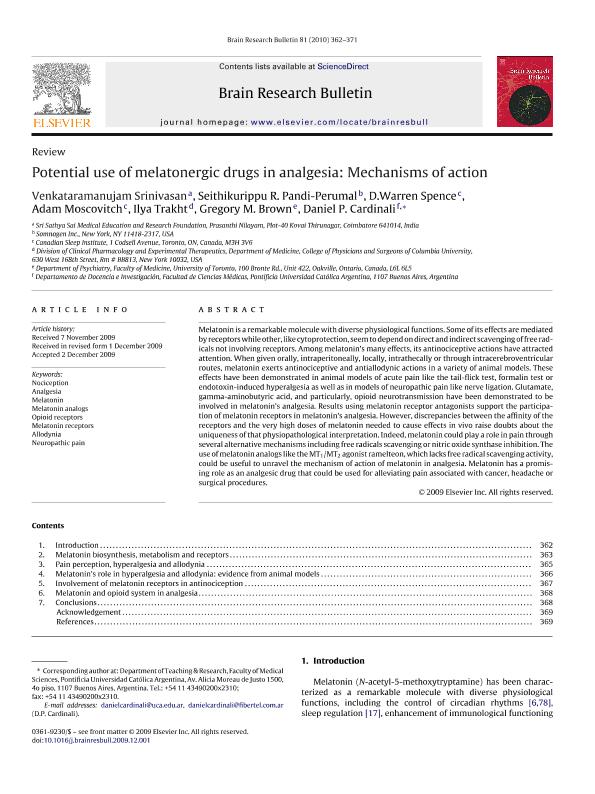Mostrar el registro sencillo del ítem
dc.contributor.author
Srinivasan, Venkataramanujam
dc.contributor.author
Pandi Perumal, Seithikurippu R.

dc.contributor.author
Spence, David Warren

dc.contributor.author
Moscovitch, Adam
dc.contributor.author
Trakht, Ilya
dc.contributor.author
Brown, Gregory M.

dc.contributor.author
Cardinali, Daniel Pedro

dc.date.available
2020-03-05T14:52:46Z
dc.date.issued
2010-03
dc.identifier.citation
Srinivasan, Venkataramanujam; Pandi Perumal, Seithikurippu R.; Spence, David Warren; Moscovitch, Adam; Trakht, Ilya; et al.; Potential use of melatonergic drugs in analgesia: Mechanisms of action; Pergamon-Elsevier Science Ltd; Brain Research Bulletin; 81; 4-5; 3-2010; 362-371
dc.identifier.issn
0361-9230
dc.identifier.uri
http://hdl.handle.net/11336/98829
dc.description.abstract
Melatonin is a remarkable molecule with diverse physiological functions. Some of its effects are mediated by receptors while other, like cytoprotection, seem to depend on direct and indirect scavenging of free radicals not involving receptors. Among melatonin's many effects, its antinociceptive actions have attracted attention. When given orally, intraperitoneally, locally, intrathecally or through intracerebroventricular routes, melatonin exerts antinociceptive and antiallodynic actions in a variety of animal models. These effects have been demonstrated in animal models of acute pain like the tail-flick test, formalin test or endotoxin-induced hyperalgesia as well as in models of neuropathic pain like nerve ligation. Glutamate, gamma-aminobutyric acid, and particularly, opioid neurotransmission have been demonstrated to be involved in melatonin's analgesia. Results using melatonin receptor antagonists support the participation of melatonin receptors in melatonin's analgesia. However, discrepancies between the affinity of the receptors and the very high doses of melatonin needed to cause effects in vivo raise doubts about the uniqueness of that physiopathological interpretation. Indeed, melatonin could play a role in pain through several alternative mechanisms including free radicals scavenging or nitric oxide synthase inhibition. The use of melatonin analogs like the MT1/MT2 agonist ramelteon, which lacks free radical scavenging activity, could be useful to unravel the mechanism of action of melatonin in analgesia. Melatonin has a promising role as an analgesic drug that could be used for alleviating pain associated with cancer, headache or surgical procedures.
dc.format
application/pdf
dc.language.iso
eng
dc.publisher
Pergamon-Elsevier Science Ltd

dc.rights
info:eu-repo/semantics/openAccess
dc.rights.uri
https://creativecommons.org/licenses/by-nc-sa/2.5/ar/
dc.subject
ALLODYNIA
dc.subject
ANALGESIA
dc.subject
MELATONIN
dc.subject
MELATONIN ANALOGS
dc.subject
MELATONIN RECEPTORS
dc.subject
NEUROPATHIC PAIN
dc.subject
NOCICEPTION
dc.subject
OPIOID RECEPTORS
dc.subject.classification
Fisiología

dc.subject.classification
Medicina Básica

dc.subject.classification
CIENCIAS MÉDICAS Y DE LA SALUD

dc.title
Potential use of melatonergic drugs in analgesia: Mechanisms of action
dc.type
info:eu-repo/semantics/article
dc.type
info:ar-repo/semantics/artículo
dc.type
info:eu-repo/semantics/publishedVersion
dc.date.updated
2020-03-04T17:34:11Z
dc.journal.volume
81
dc.journal.number
4-5
dc.journal.pagination
362-371
dc.journal.pais
Países Bajos

dc.journal.ciudad
Amsterdam
dc.description.fil
Fil: Srinivasan, Venkataramanujam. Shri Sathya Sai Medical College and Research Institute; India
dc.description.fil
Fil: Pandi Perumal, Seithikurippu R.. Somnogen; Estados Unidos
dc.description.fil
Fil: Spence, David Warren. Canadian Sleep Society; Canadá
dc.description.fil
Fil: Moscovitch, Adam. Canadian Sleep Society; Canadá
dc.description.fil
Fil: Trakht, Ilya. Columbia University College of Physicians and Surgeons; Estados Unidos
dc.description.fil
Fil: Brown, Gregory M.. University of Toronto; Canadá
dc.description.fil
Fil: Cardinali, Daniel Pedro. Pontificia Universidad Católica Argentina "Santa María de los Buenos Aires". Facultad de Ciencias Médicas; Argentina. Consejo Nacional de Investigaciones Científicas y Técnicas; Argentina
dc.journal.title
Brain Research Bulletin

dc.relation.alternativeid
info:eu-repo/semantics/altIdentifier/url/https://www.sciencedirect.com/science/article/pii/S0361923009003670
dc.relation.alternativeid
info:eu-repo/semantics/altIdentifier/doi/http://dx.doi.org/10.1016/j.brainresbull.2009.12.001
Archivos asociados
